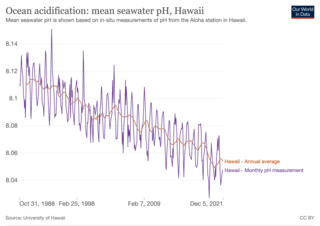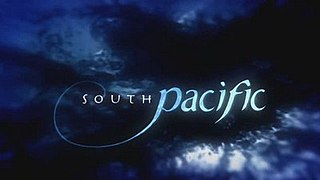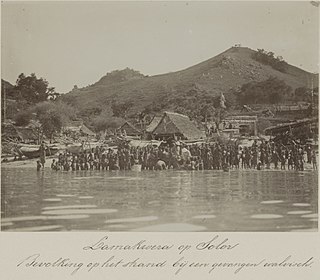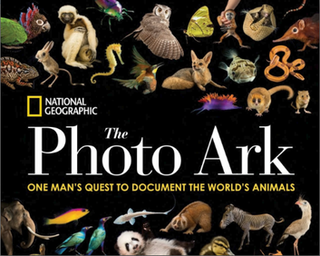
The Holocene extinction, or Anthropocene extinction, is the ongoing extinction event caused by humans during the Holocene epoch. These extinctions span numerous families of plants and animals, including mammals, birds, reptiles, amphibians, fish, and invertebrates, and affecting not just terrestrial species but also large sectors of marine life. With widespread degradation of biodiversity hotspots, such as coral reefs and rainforests, as well as other areas, the vast majority of these extinctions are thought to be undocumented, as the species are undiscovered at the time of their extinction, which goes unrecorded. The current rate of extinction of species is estimated at 100 to 1,000 times higher than natural background extinction rates and is increasing. During the past 100–200 years, biodiversity loss and species extinction have accelerated, to the point that most conservation biologists now believe that human activity has either produced a period of mass extinction, or is on the cusp of doing so. As such, after the "Big Five" mass extinctions, the Holocene extinction event has also been referred to as the sixth mass extinction or sixth extinction; given the recent recognition of the Capitanian mass extinction, the term seventh mass extinction has also been proposed for the Holocene extinction event.

Georgia Aquarium is a public aquarium in Atlanta, Georgia, United States. It exhibits hundreds of species and thousands of animals across its seven major galleries, all of which reside in more than 11 million US gallons (42,000 m3) of water. It was the largest aquarium in the world from its opening in 2005 until 2012 when it was surpassed by the S.E.A. Aquarium in Singapore and the Chimelong Ocean Kingdom in China; the Georgia Aquarium remains the largest aquarium in the United States and the fourth largest in the world.
An anoxic event describes a period wherein large expanses of Earth's oceans were depleted of dissolved oxygen (O2), creating toxic, euxinic (anoxic and sulfidic) waters. Although anoxic events have not happened for millions of years, the geologic record shows that they happened many times in the past. Anoxic events coincided with several mass extinctions and may have contributed to them. These mass extinctions include some that geobiologists use as time markers in biostratigraphic dating. On the other hand, there are widespread, various black-shale beds from the mid-Cretaceous which indicate anoxic events but are not associated with mass extinctions. Many geologists believe oceanic anoxic events are strongly linked to the slowing of ocean circulation, climatic warming, and elevated levels of greenhouse gases. Researchers have proposed enhanced volcanism (the release of CO2) as the "central external trigger for euxinia."

Wildlife conservation refers to the practice of protecting wild species and their habitats in order to maintain healthy wildlife species or populations and to restore, protect or enhance natural ecosystems. Major threats to wildlife include habitat destruction, degradation, fragmentation, overexploitation, poaching, pollution, climate change, and the illegal wildlife trade. The IUCN estimates that 42,100 species of the ones assessed are at risk for extinction. Expanding to all existing species, a 2019 UN report on biodiversity put this estimate even higher at a million species. It is also being acknowledged that an increasing number of ecosystems on Earth containing endangered species are disappearing. To address these issues, there have been both national and international governmental efforts to preserve Earth's wildlife. Prominent conservation agreements include the 1973 Convention on International Trade in Endangered Species of Wild Fauna and Flora (CITES) and the 1992 Convention on Biological Diversity (CBD). There are also numerous nongovernmental organizations (NGO's) dedicated to conservation such as the Nature Conservancy, World Wildlife Fund, the Wild Animal Health Fund and Conservation International.
Josh Ralph, known professionally as J. Ralph, is an American composer, producer, singer/songwriter and social activist who focuses on creating awareness and change through music and film.

Ocean acidification is the ongoing decrease in the pH of the Earth's ocean. Between 1950 and 2020, the average pH of the ocean surface fell from approximately 8.15 to 8.05. Carbon dioxide emissions from human activities are the primary cause of ocean acidification, with atmospheric carbon dioxide levels exceeding 410 ppm. CO2 from the atmosphere is absorbed by the oceans. This chemical reaction produces carbonic acid which dissociates into a bicarbonate ion and a hydrogen ion. The presence of free hydrogen ions lowers the pH of the ocean, increasing acidity. Marine calcifying organisms, such as mollusks and corals, are especially vulnerable because they rely on calcium carbonate to build shells and skeletons.

Leilani Maaja Münter is an American former professional stock car racing driver and environmental activist. She last competed in the ARCA Menards Series, and previously drove in the Firestone Indy Lights, the development league of IndyCar.

A wild fishery is a natural body of water with a sizeable free-ranging fish or other aquatic animal population that can be harvested for its commercial value. Wild fisheries can be marine (saltwater) or lacustrine/riverine (freshwater), and rely heavily on the carrying capacity of the local aquatic ecosystem.
This is a list of climate change topics.

Joel Sartore is an American photographer focusing on conservation, speaker, author, teacher, and long-time contributor to National Geographic magazine. He is the head of The Photo Ark, a 25-year project to document the approximately 12,000 species living in the world's zoos and wildlife sanctuaries.

South Pacific is a British nature documentary series from the BBC Natural History Unit, which began airing on BBC Two on 10 May 2009. The six-part series surveys the natural history of the islands of the South Pacific region, including many of the coral atolls and New Zealand. It was filmed entirely in high-definition. South Pacific was co-produced by the Discovery Channel and the series producer was Huw Cordey. It is narrated by Benedict Cumberbatch. Filming took place over 18 months in a variety of remote locations around the Pacific including: Anuta, Banks Islands, French Frigate Shoals, Papua New Guinea, Palmyra, Kingman Reef, Tuvalu, Palau, Caroline Islands, Tuamotus and Tanna Island in Vanuatu.

Louis (Louie) Psihoyos is an American photographer and documentary film director known for his still photography and contributions to National Geographic. Psihoyos, a certified SCUBA diver, has become increasingly concerned with bringing awareness to underwater life. In 2009, he directed and appeared in the feature-length documentary The Cove, which won an Oscar for Best Documentary Feature.

The Oceanic Preservation Society is a California-based 501(c)(3) non-profit organization that promotes marine conservation and environmental protection by combating complex global issues such as biodiversity loss, climate change, illegal wildlife trading, deforestation, and unsustainable fishing through documentary, film and media. It was founded in 2005 by Louie Psihoyos and Jim Clark. In 2009, OPS released The Cove, an Academy Award-winning documentary film that describes the annual mass slaughter of dolphins in a national park at Taiji, Wakayama.

Toughie was the last known living Rabbs' fringe-limbed treefrog. The species, scientifically known as Ecnomiohyla rabborum, is thought to be extinct, as the last specimen—Toughie—died in captivity on September 26, 2016.

Cowspiracy: The Sustainability Secret is a 2014 American documentary film produced and directed by Kip Andersen and Keegan Kuhn. The film explores the impact of animal agriculture on the environment—examining such environmental concerns as climate change, water use, deforestation, and ocean dead zones—and investigates the policies of several environmental organizations on the issue.

Hannah Fraser, known professionally as Hannah Mermaid, is a professional model, actress, dancer, and performer who specialises in underwater and ocean-oriented freediving performances, often in mermaid costume. She is a central figure in modern mermaiding and is an ocean ecology activist.

Lamakera is a village in Indonesia, on the east tip of Solor Island. It was known for being the place where the most manta rays are killed. It was featured in the 2015 documentary film, Racing Extinction. The villagers also hunted whales.

The Photo Ark is a National Geographic project, led by photographer Joel Sartore, with the goal of photographing all species living in zoos and wildlife sanctuaries around the globe in order to inspire action to save wildlife.
The poleward migration of coral species refers to the phenomenon brought on by rising sea temperatures, wherein corals are colonising cooler climates in an attempt to circumvent coral bleaching, rising sea levels and ocean acidification. In the age of Anthropocene, the changing global climate has disrupted fundamental natural processes and brought about observable changes in the submarine sphere. Whilst coral reefs are bleaching in tropical areas like the Great Barrier Reef, even more striking, and perhaps more alarming; is the growth of tropical coral species in temperate regions, which has taken place over the past decade. Coral reefs are frequently compared to the "canaries in the coal mine," who were used by miners as an indicator of air quality. In much the same way, "coral reefs are sensitive to environmental changes that could damage other habitats in the future," meaning they will be the first to visually exhibit the true implications of global warming on the natural world.















